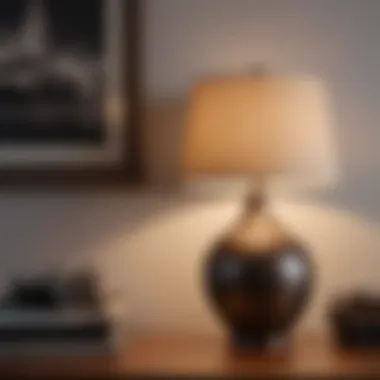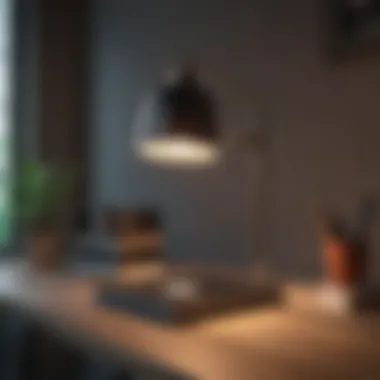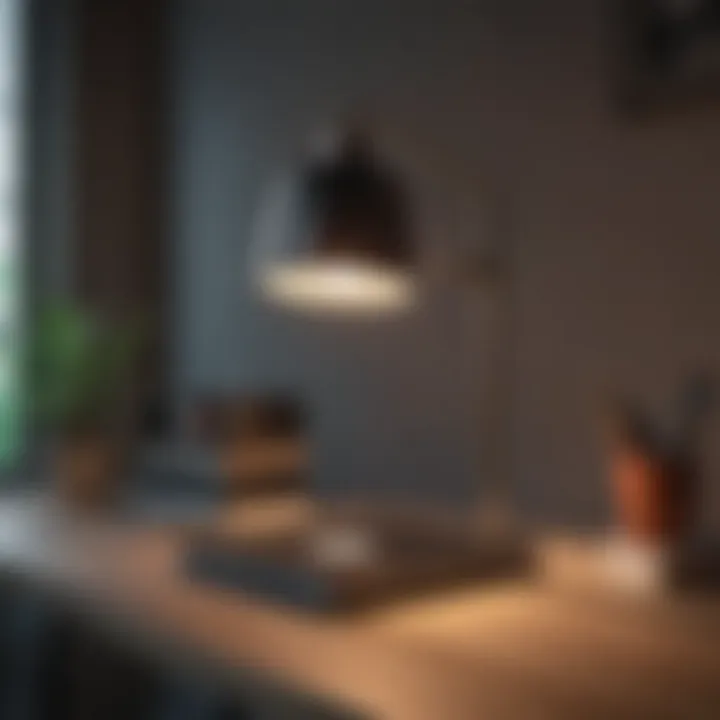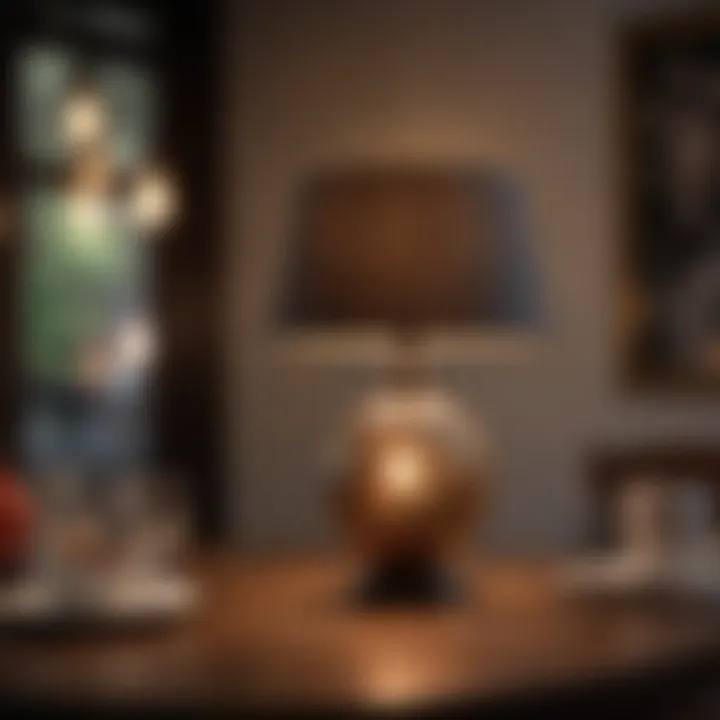Table Lamps for Small Spaces: A Detailed Guide


Intro
In today’s world, where living spaces are shrinking and the quest for style becomes ever more critical, choosing the right lighting can redefine the atmosphere of a room. Table lamps, often seen as mere fixtures, wield the power to enhance the visual appeal and functionality of a space, especially in compact areas. Not only do they serve to illuminate, but they also create a unique ambience that can transform how one perceives a small room.
In this exploration, we will deepen our understanding of the aesthetics and practicalities pertinent to table lamps in small spaces. We will look at current design trends, popular color schemes, and how proper placement can truly maximize both light and style. By the end of this piece, readers will gain the insight needed to pick the perfect table lamp, harmonizing function with the often-understated character of their environments.
Design Inspiration
Current Trends in Interior Design
As we navigate through the lively landscape of interior design, certain trends emerge that stand out, especially when considering table lamps for smaller areas. Minimalism continues to hold its ground, encouraging the use of sleek designs without unnecessary embellishments. Think about Scandinavian styles that favor light woods and simple lines. The beauty lies in their functionality, showcasing how less truly can be more.
Moreover, vintage designs are making a strong comeback—think Mid-century modern or Art Deco. These styles can inject a bit of personality into otherwise understated rooms and create conversation starters without overwhelming the space. By marrying contemporary and vintage elements, you can get a room that's as unique as it is stylish.
Color Schemes and Palette Ideas
When it comes to selecting the right color palette for your small space, it’s pivotal to consider how your table lamp integrates with the overall scheme. Neutral colors are timeless; shades like beige, soft gray, and cream create an airy feel, making them perfect companions for spaces that might feel cramped.
However, a bold accent color can be of add a touch of drama. Perhaps a deep blue or a rich emerald green can act as counterpoints to lighter wall colors, establishing a striking focal point. It’s also worthwhile to note that metallic finishes, such as matte gold or brushed nickel, can introduce a dash of elegance without visually heavy designs.
The key, after all, is balance. Whether you opt for a serene monochromatic scheme or choose contrasting colors to make a statement, the table lamp's role in the design becomes essential in echoing these visual themes throughout the space.
Prologue to Table Lamps in Design
Table lamps have long grown beyond their original role as mere providers of light; they now serve as versatile accents in interior design, particularly within the context of small spaces. This importance is magnified because lighting can make or break the ambiance of any environment. In smaller areas where every square inch counts, the choice of a table lamp plays a pivotal role in harmonizing functionality with aesthetic appeal. It can add character while also enhancing the overall mood of the area, making it not just a decorative piece but a crucial component for practical living.
The Evolution of Lighting Fixtures
The journey of lighting fixtures traces back to the crackling flames of ancient lamps, casting flickering shadows around cavernous spaces. Fast forward centuries, and we've transitioned into the age of electric lights. The emergence of table lamps specifically marks a fascinating chapter in this evolution. Initially designed to serve purely utilitarian purposes—like illuminating a reading nook or a desk—their designs gradually morphed to reflect the diverse tastes and styles of various eras. For instance, the Art Deco movement infused table lamps with geometric patterns and bold colors, while mid-century modern designs favored sleek forms and innovative materials.
Today, table lamps can be found in a myriad of styles—from minimalist to vintage; each iteration tells its own story about the period it originates from. This evolution illustrates not just innovation in technology, but also shifts in societal preferences about home aesthetics, functionality, and comfort. The interplay of form and function continues, shaping how we think about and utilize this lighting fixture in our lives.
Why Table Lamps Matter in Small Spaces
In smaller homes or tight corners, table lamps are akin to secret weapons in the arsenal of design enthusiasts. These little powerhouses provide focused lighting that can spotlight important areas while also creating an inviting atmosphere. Here are a few reasons why table lamps hold such significance in compact environments:
- Space Optimization: They can easily tuck into nooks or serve dual purposes, like a lamp doubling as a decor piece.
- Versatility in Style: With countless designs available, it's possible to find one that complements your existing decor, helping to tie the whole room together.
- Light Control: Unlike overhead lighting, table lamps allow users to dictate the level and intensity of light, suitable for various tasks or moods.
"In a small room, a well-chosen table lamp can be the difference between feeling cramped and feeling cozy."
In summation, table lamps are vital in maximizing the utility and ambiance of small spaces. They possess a unique ability to influence the interpretation of a room's size and warmth, and their thoughtful integration can enhance living experiences in ways that one might not immediately consider. As we delve further into the nuances of lighting design, it's crucial to appreciate the foundational role that these lamps play in crafting functional and aesthetically pleasing environments.
Understanding Space Limitations
Understanding space limitations is crucial for anyone navigating the nuances of decorating small environments. It goes beyond simply adding furniture; it's about creating a harmonious atmosphere that balances light, style, and functionality. Table lamps are often the unsung heroes in this context, capable of transforming a small corner into a welcoming nook or a vibrant workspace.
Identifying Small Space Challenges
When faced with a compact area, several challenges arise that can hinder the design process. These challenges include:
- Limited Surface Area: In small spaces, every inch counts. There might not be enough room for large furniture or decoration without cramping the area.
- Proximity Issues: Furniture can be closely arranged, creating potential obstacles for movement. This can also affect lighting configurations as light may not reach the areas it’s intended to illuminate.
- Visual Weight: A crowded area might feel heavy or cluttered. This can impact how one perceives the room and, inevitably, the overall atmosphere.
A good example is a tiny studio apartment where having a large table lamp might overshadow the space, leading to a disjointed look. Instead, opting for a slender, tall lamp can amplify both functionality and aesthetics.
Spatial Orientation and Layout Considerations
The layout of a small space essentially dictates the utility of each item placed within it. Understanding spatial orientation means being mindful of where and how to position a table lamp effectively:
- Focal Points: Identify key areas that require illumination. In most cases, these include reading nooks or workspaces. A lamp should not only provide necessary light but also draw attention to these focal points.
- Flow of Movement: Ensure that there’s a clear pathway through the space. A lamp placed in a walkway can become an annoying obstacle. Instead, consider locations where it enhances rather than limits mobility.
- Layering Light: Aim for varied light sources. Using multiple smaller table lamps can distribute light evenly, creating a more inviting atmosphere while keeping the space open and breezy.


By addressing these factors, one not only optimizes the usage of the available space but also contributes to a smoother experience in daily activities, helping to make small areas feel expansive and welcoming.
"Small spaces can be your greatest design challenge, but they also offer the chance for creative solutions that larger rooms do not demand."
In summary, understanding space limitations is a blend of recognizing distinct challenges and implementing thoughtful, strategic design choices to enhance small environments. With careful consideration, anyone can transform a compact area into a functional, stylish abode.
The Role of Lighting in Interior Design
When it comes to crafting a well-designed interior space, lighting often takes center stage. Not merely a practical necessity, light serves as a transformative element that can dramatically alter the mood and perception of any area. In small spaces, where every square inch counts, understanding the role of lighting becomes even more crucial. Properly chosen and strategically placed table lamps can enhance aesthetics, create ambiance, and improve functionality, making them indispensable tools for homeowners and designers alike.
Impact of Light on Perception of Space
The interplay of light and space is intricate. Bright areas can make a nook feel airy and open, while dim corners can create an enveloping coziness. In a compact room, effective lighting is pivotal in manipulating visual perception. For instance, using brighter table lamps in darker corners can eliminate stark shadows and create a more inviting atmosphere.
Consider the way light reflects off surfaces. A glossy white table lamp, positioned correctly, can bounce light around a room, making it feel larger than it actually is. Similarly, dark colors can absorb light and make a space feel more confined. Thus, choosing the right finish and color for a lamp becomes essential for achieving the desired spatial effect.
"Light is the magical ingredient that unveils the hidden dimensions of any space."
Task vs. Ambient Lighting
When we think of lighting, it often splits into two main categories: task lighting and ambient lighting. Each serves a distinct purpose and has a unique impact on small spaces.
- Task Lighting: This type of lighting is focused on specific areas where tasks are performed. For example, a table lamp used for reading or working becomes an essential part of any functional setup. The brightness and direction of the bulb can significantly enhance productivity and focus, especially in a limited-area like a small desk.
- Ambient Lighting: On the other hand, ambient lighting casts a more general and even glow across an area. It’s about creating a soothing overall environment. The clever use of table lamps as ambient light sources can soften harsh overhead lighting and make a small space feel warm and welcoming.
Understanding the balance between task and ambient lighting is key. For instance, utilizing a stylish table lamp for ambient lighting while providing a stronger desk lamp for tasks can cater to both needs. This layering of light creates depth and interest, making the space not just functional but visually engaging.
In summary, when designing small interiors, one must keep in mind the influential role of light. Carefully selected and placed table lamps can not only brighten up those confined spaces but also enhance the overall interior design scheme, making every corner feel purposeful.
Choosing the Right Table Lamp
Selecting the ideal table lamp is not just about illuminating a space. It bridges function and design, particularly when working within the confines of small spaces. A well-considered table lamp goes beyond being a mere light source; it has the power to enhance the ambiance and aesthetics of a room, playing a pivotal role in your interior design strategy.
When choosing a lamp, several key elements come into play. Firstly, identify your lighting needs. Is it to create a cozy atmosphere, or is it aimed at providing clear task lighting? Your choice will significantly influence the effectiveness of the lamp in fulfilling its purpose. Beyond functionality, the lamp must complement your existing decor. Consider how it fits within the overall theme—whether you’re aiming for something contemporary, vintage, or a blend of styles.
Understanding Styles and Aesthetics
Every design has its own character, and table lamps are no exception. From sleek modern designs to ornate traditional pieces, each lamp carries a distinct personality. It's essential to ponder how a lamp's style interacts with other elements in the space. For instance, a rustic lamp can provide a lovely contrast in a sleek, ultra-modern room. However, harmony is equally crucial. Look for lamps that share similar materials, colors, or patterns with your surrounding furniture. This creates a cohesive look.
- Material Matters: Metal, glass, ceramic—each material confers a different vibe. Glass shades can soften light, ceramic can add warmth, while metal often embodies a more industrial feel.
- Size and Proportion: A small lamp can get dwarfed in a large space, while a lamp that’s too bulky can overwhelm a tiny area. Measure any available surfaces to find a lamp that balances appropriately.
- Color Considerations: The color of a lamp can either make it a statement piece or allow it to blend into its surroundings. Bold colors can energize a room, while muted shades promote serenity.
Navigating Bulb Options and Brightness
Lighting is as much about functionality as it is about mood. Once you've narrowed down your style, consider the type of bulb that will bring the lamp to life. LED bulbs are popular for their energy efficiency, while incandescent bulbs provide a warmer glow.
- Brightness Levels: Not all lamps serve the same purpose. A reading lamp requires a brighter bulb compared to a lamp intended for ambient lighting. Pay attention to lumens (the measure of light output); more lumens mean brighter light.
- Bulb Socket Types: Check the socket type before you buy. Some bulbs are not interchangeable with every lamp.
"Choosing a table lamp is more than making a purchase; it's about transforming your space and setting the tone for your home."
Selecting the right table lamp can evolve from a simple task to a crucial aspect of interior design when approached thoughtfully. Each bulb choice, style decision, and spatial consideration coalesces into the overall narrative of a room, balancing the need for light with elements of beauty.
Design Techniques for Small Spaces
When it comes to making the most out of small living areas, understanding design techniques is crucial. In the context of this article, the focus on table lamps as a design element stems from their ability to not only illuminate but also serve as stylistic accents that enhance the overall aesthetic of a space. Emphasizing efficient design can make even the tiniest nook feel inviting and functional.
Table lamps can be the perfect solution to brighten up cramped corners and enhance the mood without cluttering the area. Their placement and functionality become fundamental to creating a harmonious ambiance. Here, we dive into two significant design techniques that offer innovative solutions in small spaces.
Utilizing Vertical Space
In small interiors, real estate is often at a premium. One effective way to capitalize on this is by utilizing vertical space. It’s about thinking upwards rather than spreading out. This method involves placing table lamps on higher surfaces, such as tall dressers, shelves, or wall-mounted brackets. Not only does this free up space on the floor but it also draws the eye upwards, creating an illusion of height and depth.
Consider a table lamp with a long neck, which can be placed on a taller stand or pedestal. This design allows for better light distribution while minimizing visual clutter. Hanging fixtures can serve a similar purpose, providing necessary light without consuming valuable surface area. It’s a clever trick that can elevate the overall perception of any room, making it feel larger and airier.


Some practical ideas to maximize vertical space include:
- Stacking design elements: Combine decor elements on high shelves with lamps to create layered visual interest.
- Wall sconces: Use low-profile wall sconces paired with table lamps to enhance the lighting scheme without cluttering surfaces.
- Adjustable lamps: Choose lamps with adjustable arms that can be nestled against a wall or a higher spot, providing direct light where needed.
Incorporating Multi-Functional Furniture
Another significant strategy for small spaces is the incorporation of multi-functional furniture. This involves choosing pieces that serve more than one purpose, which can be a true game-changer in limited areas. For instance, a side table that doubles as a lamp stand can be a remarkable space-saver. This concept eliminates the need for standalone tables, allowing for additional room to breathe.
When selecting lamps, opt for those that blend seamlessly with the furniture while still having an independent function. For example, a lamp integrated into a bookshelf serves as a lighting source while enhancing the display of books and decorative items. Multi-functional designs not only help save on space but also add unique character to your space.
Key benefits for choosing multi-functional furniture include:
- Increased functionality: Provides various usages, which ensures the area remains uncluttered.
- Cost efficiency: Reduces the need to purchase multiple pieces.
- Visual harmony: Attains a cohesive look while preserving practicality.
"The right design techniques can turn a small space into a stylish sanctuary. Often, it's about placing the right essential pieces in thoughtful ways."
By understanding the significance of utilizing vertical spaces and incorporating multi-functional furniture, homeowners can approach their design challenges with a refreshed perspective. In small spaces, every inch counts, and thoughtful placement along with smart design can redefine how we interact with our surroundings.
Placement Strategies for Maximum Impact
The arrangement of table lamps in small spaces often dictates the overall atmosphere and functionality of the area. Careful consideration of placement can make the difference between a cluttered, dim room and a cozy, inviting nook. Here, we dive into the intricacies that can maximize not just illumination but also aesthetic appeal.
Optimal Areas to Position Table Lamps
Finding the ideal spots for table lamps is crucial for enhancing both light distribution and room perception. Some tried-and-true locations include:
- Side Tables: Placing a lamp on a bedside table can facilitate reading or late-night activities without overwhelming the design.
- Console Tables: When entering a room, a console table with a thoughtfully placed lamp provides immediate illumination while adding layers to the decor.
- Corners: A lamp tucked away in a corner can brighten up shadows while visually expanding the space. Consider using a slim model that won't take up too much real estate.
The key is to ensure that lamps are accessible and serve their primary function: offering light where it’s needed most.
Balancing Proportions and Scale
When positioning table lamps, balance is everything. The size of the lamp relative to furniture is essential in maintaining harmony within the space. Lamps that are too large can overshadow and make a small area feel even smaller. Conversely, tiny lamps may disappear in the surroundings, failing to make a statement.
Tips to Achieve Balance:
- Height Matters: A lamp should typically be around eye level when seated. This consideration aids in minimizing glare while providing optimal illumination.
- Matching Styles: Align the lamp's aesthetic with the surrounding decor. For example, a sleek modern lamp placed next to vintage furniture can create a jarring visual experience.
- Layering Heights: Mix and match lamp heights within a room. A tall lamp next to a low profile furniture can guide the eye upward, making the space appear larger.
"The right lamp in the right place can transform a space, adding both light and elegance, and is a subtle art that requires attention to detail."
Being intentional about where and how table lamps are positioned creates not only a functional light source but enriches the visual narrative while underscoring the unique characteristics of small spaces.
Innovative Lighting Solutions
Innovative lighting solutions stand at the forefront of modern design, especially for small spaces where every inch counts. These creative approaches not only maximize the utility of limited areas but also inject a fresh wave of style into interior decor. From multifunctional features to cutting-edge technology, the realm of table lamps has expanded, providing homeowners and design enthusiasts alike with diverse options that cater to both aesthetic desires and practical needs.
Portable and Cordless Options
In smaller domains, flexibility is key. Portable and cordless table lamps epitomize this adaptability, allowing users to illuminate not just tables but also nooks and crannies that might have gone unnoticed otherwise. These lamps often come equipped with rechargeable batteries, eliminating the need for cumbersome cords that can create hazards or clutter.
- Benefit of Flexibility: You can move them around to provide extra light for reading in bed or brightening up a seating area when entertaining guests.
- Design Versatility: Often available in sleek, modern designs or even rustic styles, they can match various decor themes seamlessly.
Employing lights that are both stylish and functional, homeowners might find themselves gravitating toward options from brands like BenQ or LumiCharge, which offer lamps that are compact yet powerful, perfect for tight living arrangements.
Smart Table Lamps and Their Benefits
The rise of smart technology has permeated lighting solutions as well, offering table lamps equipped with features that extend far beyond traditional functionality. Smart table lamps allow users to customize lighting according to their needs with just a smartphone app or voice command.
- Control at Your Fingertips: Whether it’s dimming the lights for a cozy movie night or ramping them up for that intimate dinner party, having adjustable brightness is a game-changer.
- Integration with Smart Homes: Many smart table lamps integrate with home assistants like Amazon Alexa or Google Assistant, enabling a seamless lighting experience—no need to get up and flip a switch.
Furthermore, these lamps often come with features like built-in USB ports, offering added convenience for charging devices without needing extra outlet space. The combination of form, function, and technology results in compelling lighting options that resonate well with today’s tech-savvy homeowner.


The advantages of incorporating innovative lighting solutions into limited spaces ensure not just enhanced functionality but also a boost in the aesthetic appeal of the home.
In summary, as we explore these innovative lighting options, we see a clear trend towards flexibility and technology-driven design—essentials for anyone looking to maximize their small space. The emergence of portable, cordless, and smart table lamps lightens the burden of limited square footage, transforming our homes into functional yet stylish havens.
Material and Color Considerations
When it comes to table lamps in compact settings, material and color choices make a world of difference. These elements not only serve functional purposes but also contribute significantly to the overall aesthetic of a space. The right materials can enhance the ambiance, making a room feel more open or cozy depending on the desired effect. Colors, too, can evoke different feelings and influence how a room is perceived.
Choosing Materials That Enhance Ambiance
Selecting the right materials is essential for balancing aesthetics and functionality. Common materials for table lamps include metal, glass, ceramic, and fabric. Each material brings a unique character to a space:
- Metal: Metal lamps often project a modern vibe. They can introduce a sleek look to a minimalist environment. Consider brushed nickel or matte black for a sophisticated feel.
- Glass: Glass lamps are great at reflecting light. They create a feeling of openness, making them ideal for small areas where light plays an important role. A frosted finish can soften the light, adding warmth.
- Ceramic: Often available in various colors and shapes, ceramic lamps can inject a splash of personality into a room. They work well in eclectic or traditional decors.
- Fabric: Lampshades made of fabric add texture and often diffuse light beautifully. The warmth of fabric can create a cozy atmosphere, which is particularly desirable in smaller spaces.
In addition to aesthetics, it's crucial to consider the durability and maintenance of the materials chosen. For example, metal may require less upkeep than fabric, which can collect dust and stains. Thus, understanding the specific needs and potential wear of each material can guide your choices effectively.
The Psychological Impact of Color
Colors wield immense power over mood and perception, especially in small spaces. The right shades can make a room feel larger, warmer, or more vibrant. When contemplating color for table lamps, think about how each hue contributes to the overall vibe.
- Light Colors: Soft whites, pastels, or light grays can create an illusion of more space. They reflect light well, which can make compact areas seem more expansive.
- Darker Colors: Deep hues like navy blue or charcoal can add drama. While they may not necessarily enlarge a room visually, they can create a strong focal point that draws the eye, lending depth.
- Warm Tones: Colors such as browns, oranges, and reds are often associated with comfort and warmth. These colors are great for creating a welcoming environment, ideal for spaces that host gatherings.
- Cool Tones: Blues and greens tend to have a calming effect. They are perfect for relaxing areas, such as reading nooks or bedrooms.
Choosing colors shouldn't be done in a vacuum. It’s wise to consider how these tones interact with the rest of the decor—walls, furniture, and even artwork. Pairing complementary colors can help tie a room together.
"Color is the keyboard, the eyes are the harmonies, the soul is the piano with many strings." – Wassily Kandinsky
In summary, the considerations of material and color are not just technical choices but an artful blend that can transform small spaces. Understanding these elements enables homeowners and design aficionados to captivate their audience and create stunning environments.
Maintenance and Care of Table Lamps
Maintaining table lamps is essential for both their aesthetics and functionality. Proper care enhances their longevity and ensures they continue to illuminate small spaces effectively. It's easy to overlook this aspect when caught up in the design choices or placement strategies, but taking the time to maintain these fixtures greatly reduces the risk of malfunction and keeps the atmosphere flattering. Additionally, regular upkeep can prevent dirt and grime from dulling the lamp’s finish, preserving its charm longer.
Regular Cleaning Practices
Keeping table lamps dust-free is not only about looks; it contributes to their performance. Here are a few simple yet effective cleaning practices:
- Use a Soft Cloth: Begin with a microfiber cloth to gently wipe down the surface. This helps to capture dust without scratching any delicate finish.
- Light Bulb Care: The bulbs themselves can get grungy. It’s wise to switch them off and let them cool, then wipe them down dexterously. Dirt on bulbs can reduce light output, dimming their glow in tight corners.
- Monthly Deep Clean: Every month, it’s beneficial to perform a more thorough cleaning. Remove the lampshade, if possible, and clean it according to its material. For fabric shades, it could be as simple as a light vacuuming, while glass shades might need a gentle wash in warm soapy water.
- Pay Attention to the Base: Don’t forget about the lamp base. A mixture of warm water and a gentle detergent can help keep wooden or metal bases looking sharp.
Keeping up with these practices ensures your lamps don’t just sit there looking pretty but actually function well, contributing their part to the overall lighting schematic of your space.
Handling Bulb Replacement
Replacing bulbs might seem straightforward, but following a few essential steps ensures safety and efficiency. Here’s how to handle it:
- Turn It Off: For starters, ensure the lamp is unplugged or switched off. You wouldn’t want to be shocked if a bulb is stubborn.
- Choose the Right Bulb: When replacing the bulb, it’s crucial to consider the wattage and base type. Review the specifications mentioned on the lamp or within its manual. A wrong wattage can lead to user dissatisfaction or even damage.
- Gently Remove the Old Bulb: Hold the base of the bulb and twist it counterclockwise carefully. If a bulb is stuck, taking your time and using a cloth for a better grip can help.
- Install the New Bulb: Line up the base of your new bulb with the socket and twist clockwise until it’s secure. Avoid forcing it; you don’t want to break the filament inside.
- Final Check: Once the bulb is in place, plug in the lamp and power it up. If it lights up, congrats! You’ve done it right. But if it flickers or doesn’t turn on, double-check the connections.
Taking care of bulb replacements properly prolongs the life of your table lamps and ensures that your cozy corners remain illuminated with the right ambiance.
Epilogue
When it comes to creating functional and inviting environments in compact areas, table lamps play a pivotal role. This article has explored various aspects of table lamps and their significance in small spaces. The crux of the matter is that lighting goes beyond utility; it’s about how light interacts with the surrounding decor and influences mood. A well-placed table lamp can transform a cluttered corner or an overlooked side table into a cozy reading nook or an accent spot.
Recap of Key Points
To recap, here are some significant points highlighted throughout the article:
- Design Variability: Table lamps come in a plethora of styles, materials, and sizes, making them adaptable to varied aesthetics. From minimalist to baroque, any design sensibility can be met.
- Optimal Placement: Thoughtful positioning of table lamps can enhance the overall ambience. Consider placing lamps in corners, on shelves, or as centerpieces on side tables to maximize their effect.
- Material Matters: The choice of materials contributes immensely to the vibe of the space. Light metals lend a modern touch, while wood adds warmth.
- Color Psychology: Colors of lampshades influence how light is perceived and can evoke specific emotions. Soft hues can promote relaxation, while brighter colors may energize.
- Maintenance: Keeping lamps clean and functioning is crucial for longevity and visual appeal. Regular dusting and timely bulb replacements keep their charm intact.
By understanding these facets, homeowners, designers, and enthusiasts can make informed decisions that not only enhance the practicality of their spaces but also contribute to aesthetic values.
Future Trends in Table Lamp Design
As we look ahead, several trends in table lamp design are gradually gaining traction:
- Smart Technology: With the rise of smart home devices, table lamps that integrate mobile connectivity and adjustable light settings are becoming commonplace. These devices can be adjusted via apps, allowing users to tailor lighting based on time of day or activity.
- Sustainability: Eco-friendly materials are on the rise. Lamps made from recyclable resources or featuring energy-efficient LED bulbs are becoming more sought after, appealing to environmentally-conscious consumers.
- Customization Options: Customizable elements such as interchangeable lampshades and adjustable heights or bases are capturing the market’s attention. This allows users to personalize their lamps to suit seasonal decor changes or personal tastes.
- Geometric Designs: A departure from traditional forms, geometric shapes and asymmetrical designs are attracting a younger audience. These lamps not only function as lighting solutions but become statements in their own right.
By embracing these trends, whether it’s introducing smart capabilities or opting for sustainable materials, individuals can stay ahead of the curve in their quest for distinctiveness in interior design. As they say, the light at the end of the tunnel is always brighter when it’s well designed.



